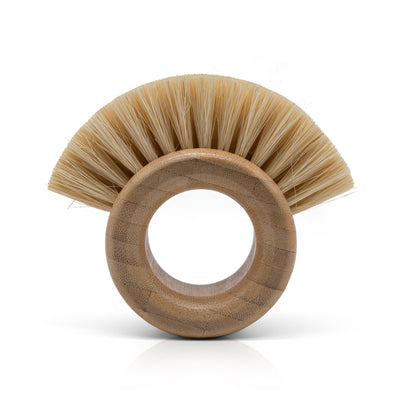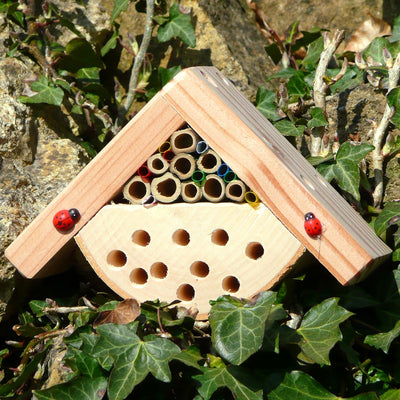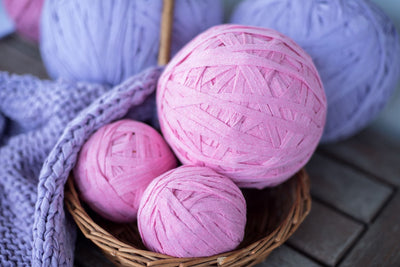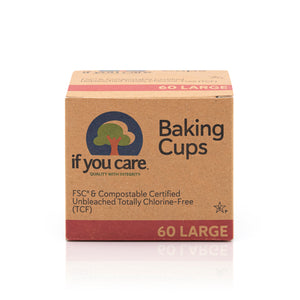By creating an account with our store, you will be able to move through the checkout process faster, store multiple shipping addresses, view and track your orders in your account and more.








Product description & details
How do food bag clips work?
In the UK, we waste almost half of all the bread we produce - around 24 million slices of bread every day! That’s loaves of food that could have been eaten, and we’re sure a good bag clip could have prevented premature spoiling in a lot of cases.
A food bag clip helps to preserve shelf life of food items by minimising the air flow into the bag and reducing exposure to oxygen, moisture and environmental temperatures that contribute to the degradation. Oh, and they help deter bugs and flies from getting their hands on your good food, too!
How to use your doughnut clips for food bags
A great addition to your household supplies, simply fold over the ends of your packet or bag a few times and slide the wooden ring over the seam for a snug fit. It’s a sustainable way to close paper packets or plastic bags to keep the contents fresher for longer. Ideal for crisps, crackers, coffee, cereal, pastries, snacks, dried food, bread and more…
Why use a wooden food bag clip?
We all know the frustration of crackers, crisps or coffee going stale in the blink of an eye. That’s where wooden food clips come in handy to seal in the freshness so all your snacks and dried foods stay better for longer. So the packet of crackers in the cupboard or those baked goods you’re saving for breakfast tomorrow can last another day (or week!) without leaving you disappointed.
Whether you need to keep cereal crunchy, seal up snacks for school lunches or keep baking ingredients fresh, ecojiko’s wooden food clips are a smart and sustainable solution. Eco-friendly food storage clips like these help you throw away less food because of premature spoiling and are therefore a great way to reduce your food waste as well.
Since these plastic-free bag clips for food are made from natural beechwood, they’re completely biodegradable and won’t pollute the planet like plastic clips.
They also make lovely housewarming presents or thoughtful eco-friendly gifts any home chef would love!
How to care for your bamboo or wooden utensils and household supplies
Ensuring the longevity of your natural wooden utensils, cleaning tools and household products is key to maintaining their functionality and cost-saving benefits. These sustainable materials, while eco-friendly, are more porous than traditional plastics, making them susceptible to warping and cracking when exposed to water or heat for extended periods.
That means steering clear of the dishwasher and refraining from soaking in water for prolonged periods.
Can you put wooden dish brushes in the dishwasher?
Due to the natural materials, wooden utensils are not suitable for the dishwasher. Although dishwashers seem like a convenient cleaning solution, the high heat and excess moisture inside them can cause irreversible damage to wooden or bamboo products including brushes, scrubbers, lids and chopping boards, so be sure to wash them by hand every time.
How to clean products made from natural materials
Products made from natural materials such as bamboo lids and dish brushes or wooden spoons and chopping boards need a little extra maintenance if you want them to last a long time. Looking after your sustainable cleaning tools and kitchen supplies extends their lifespan and reduces the number of times you need to replace them, saving you more money in the long run.
Always wash wooden or bamboo products by hand in warm soapy water, and remember to dry properly. Don’t use bleach or strong chemical cleaners as this can damage natural products like bamboo and beechwood. We recommend opting for gentle but effective eco-friendly cleaners like our OceanSaver Eco Dish Washing Bar which removes tough stains while preserving natural materials.
How to keep plastic-free dish brushes clean
Sustainable cleaning brushes made from natural sisal and coconut bristles clean just as well as their plastic counterparts but without the environmental damage.
These natural plastic-free bristle brushes are designed to biodegrade and not linger in landfills, but to ensure they remain effective and durable, you need to look after them properly. A good care routine is a great way to maintain your natural brushes and save you money in the long run.
After each use, clean your eco-friendly brushes thoroughly by removing any food bits trapped between the bristles and allow them to dry out completely with the bristles facing down to drain off the water. Avoid leaving the handles of your bamboo dish brushes and pot scrubbers submerged in water for any length of time and keep them away from the dishwasher to prevent damage.
How long do bamboo dish brushes and kitchen tools last?
Bamboo dish brushes and pot scrubbers can last a long time with the right care. Just like your trusty wooden spoon or chopping board, they can survive years and years of use before you need to replace them.
For example, the ecojiko long handle dish brush is designed to last years as the removable brush heads can easily be replaced once they’re worn out.
How often should you replace a bamboo dish brush
Our eco-friendly cleaning brushes and scrubbers can be used for several months before you need to replace them.
With regular use, you may need to change your replaceable dish brush head every 3-6 months, although some people find their bamboo dish brushes and pot scrubbers can last 6-12 months, or even longer in some cases!
If you keep them clean and allow them to dry out properly, your plastic-free kitchen and cleaning tools will do you proud. You can use a gentle disinfectant to prevent bacteria from building up in between uses, too.
When to change your wooden brushes and cleaning tools
You’ll know when it’s time to replace your wooden dish brush or bamboo scrubbing brush when the bristles start showing signs of wear and tear, like fraying or losing their stiffness. Once they begin to bend or fray, it’s a subtle hint that they’ve put in their fair share of cleaning shifts. Keep an eye out for any splits or cracks in the bamboo handles too - that's a cue that it's nearing retirement. When your trusty eco brush starts looking more tired than your post-cleaning self, it might be time to bid adieu and let a fresh one take over the scrubbing duty!
What’s more, those bamboo dish brush heads and pot scrubbers can happily join your compost heap once their cleaning days are over, contributing to nature's cycle instead of cluttering up landfills for centuries like their plastic counterparts. Winner!
Why choose products made from natural materials instead of plastic?
Choosing sustainable cleaning tools and household supplies made from natural, non-plastic materials like bamboo, beechwood, sisal and coconut is a conscious step toward reducing single-use plastic in your household and combatting plastic pollution at a greater scale.
Ecojiko’s cleaning utensils and household products are made from 100% FSC-certified bamboo or beechwood, with natural sisal or coconut bristles on all eco-friendly brushes. This FSC certification means that the bamboo and beechwood used in these products are harvested responsibly without contributing to deforestation, while also supporting plant and animal conservation, local communities, fair wage and work environments.
Plastic-free cleaning tools and kitchen utensils like these will naturally biodegrade rather than lasting centuries in landfill like plastic alternatives. And due to the all-natural materials, you can throw the dish brush heads or scrubbing brushes into the compost once they’re worn out!
What makes bamboo better for the environment?
Despite sharing similar qualities and appearance to wood, bamboo is actually a type of grass. But what makes it such a great alternative to traditional wood?
Bamboo is a renewable crop that’s stronger than your average hardwood and quicker to replenish. It’s durable, recyclable, biodegradable and incredibly sustainable.
In fact, bamboo is the fastest growing plant on the planet, reaching almost a metre a day! It’s usually harvested every 3-5 years compared to the 40-150 years required to grow trees ready to fell for timber, with no nasty pesticides needed to thrive.
But it gets better than that! Research shows that bamboo absorbs more carbon dioxide (as much as 12 tonnes of CO₂ per hectare per year) and releases 35% more oxygen than traditional timber plantations. Pretty impressive, right?
How do food bag clips work?
In the UK, we waste almost half of all the bread we produce - around 24 million slices of bread every day! That’s loaves of food that could have been eaten, and we’re sure a good bag clip could have prevented premature spoiling in a lot of cases.
A food bag clip helps to preserve shelf life of food items by minimising the air flow into the bag and reducing exposure to oxygen, moisture and environmental temperatures that contribute to the degradation. Oh, and they help deter bugs and flies from getting their hands on your good food, too!
How to use your doughnut clips for food bags
A great addition to your household supplies, simply fold over the ends of your packet or bag a few times and slide the wooden ring over the seam for a snug fit. It’s a sustainable way to close paper packets or plastic bags to keep the contents fresher for longer. Ideal for crisps, crackers, coffee, cereal, pastries, snacks, dried food, bread and more…
Why use a wooden food bag clip?
We all know the frustration of crackers, crisps or coffee going stale in the blink of an eye. That’s where wooden food clips come in handy to seal in the freshness so all your snacks and dried foods stay better for longer. So the packet of crackers in the cupboard or those baked goods you’re saving for breakfast tomorrow can last another day (or week!) without leaving you disappointed.
Whether you need to keep cereal crunchy, seal up snacks for school lunches or keep baking ingredients fresh, ecojiko’s wooden food clips are a smart and sustainable solution. Eco-friendly food storage clips like these help you throw away less food because of premature spoiling and are therefore a great way to reduce your food waste as well.
Since these plastic-free bag clips for food are made from natural beechwood, they’re completely biodegradable and won’t pollute the planet like plastic clips.
They also make lovely housewarming presents or thoughtful eco-friendly gifts any home chef would love!
How to care for your bamboo or wooden utensils and household supplies
Ensuring the longevity of your natural wooden utensils, cleaning tools and household products is key to maintaining their functionality and cost-saving benefits. These sustainable materials, while eco-friendly, are more porous than traditional plastics, making them susceptible to warping and cracking when exposed to water or heat for extended periods.
That means steering clear of the dishwasher and refraining from soaking in water for prolonged periods.
Can you put wooden dish brushes in the dishwasher?
Due to the natural materials, wooden utensils are not suitable for the dishwasher. Although dishwashers seem like a convenient cleaning solution, the high heat and excess moisture inside them can cause irreversible damage to wooden or bamboo products including brushes, scrubbers, lids and chopping boards, so be sure to wash them by hand every time.
How to clean products made from natural materials
Products made from natural materials such as bamboo lids and dish brushes or wooden spoons and chopping boards need a little extra maintenance if you want them to last a long time. Looking after your sustainable cleaning tools and kitchen supplies extends their lifespan and reduces the number of times you need to replace them, saving you more money in the long run.
Always wash wooden or bamboo products by hand in warm soapy water, and remember to dry properly. Don’t use bleach or strong chemical cleaners as this can damage natural products like bamboo and beechwood. We recommend opting for gentle but effective eco-friendly cleaners like our OceanSaver Eco Dish Washing Bar which removes tough stains while preserving natural materials.
How to keep plastic-free dish brushes clean
Sustainable cleaning brushes made from natural sisal and coconut bristles clean just as well as their plastic counterparts but without the environmental damage.
These natural plastic-free bristle brushes are designed to biodegrade and not linger in landfills, but to ensure they remain effective and durable, you need to look after them properly. A good care routine is a great way to maintain your natural brushes and save you money in the long run.
After each use, clean your eco-friendly brushes thoroughly by removing any food bits trapped between the bristles and allow them to dry out completely with the bristles facing down to drain off the water. Avoid leaving the handles of your bamboo dish brushes and pot scrubbers submerged in water for any length of time and keep them away from the dishwasher to prevent damage.
How long do bamboo dish brushes and kitchen tools last?
Bamboo dish brushes and pot scrubbers can last a long time with the right care. Just like your trusty wooden spoon or chopping board, they can survive years and years of use before you need to replace them.
For example, the ecojiko long handle dish brush is designed to last years as the removable brush heads can easily be replaced once they’re worn out.
How often should you replace a bamboo dish brush
Our eco-friendly cleaning brushes and scrubbers can be used for several months before you need to replace them.
With regular use, you may need to change your replaceable dish brush head every 3-6 months, although some people find their bamboo dish brushes and pot scrubbers can last 6-12 months, or even longer in some cases!
If you keep them clean and allow them to dry out properly, your plastic-free kitchen and cleaning tools will do you proud. You can use a gentle disinfectant to prevent bacteria from building up in between uses, too.
When to change your wooden brushes and cleaning tools
You’ll know when it’s time to replace your wooden dish brush or bamboo scrubbing brush when the bristles start showing signs of wear and tear, like fraying or losing their stiffness. Once they begin to bend or fray, it’s a subtle hint that they’ve put in their fair share of cleaning shifts. Keep an eye out for any splits or cracks in the bamboo handles too - that's a cue that it's nearing retirement. When your trusty eco brush starts looking more tired than your post-cleaning self, it might be time to bid adieu and let a fresh one take over the scrubbing duty!
What’s more, those bamboo dish brush heads and pot scrubbers can happily join your compost heap once their cleaning days are over, contributing to nature's cycle instead of cluttering up landfills for centuries like their plastic counterparts. Winner!
Why choose products made from natural materials instead of plastic?
Choosing sustainable cleaning tools and household supplies made from natural, non-plastic materials like bamboo, beechwood, sisal and coconut is a conscious step toward reducing single-use plastic in your household and combatting plastic pollution at a greater scale.
Ecojiko’s cleaning utensils and household products are made from 100% FSC-certified bamboo or beechwood, with natural sisal or coconut bristles on all eco-friendly brushes. This FSC certification means that the bamboo and beechwood used in these products are harvested responsibly without contributing to deforestation, while also supporting plant and animal conservation, local communities, fair wage and work environments.
Plastic-free cleaning tools and kitchen utensils like these will naturally biodegrade rather than lasting centuries in landfill like plastic alternatives. And due to the all-natural materials, you can throw the dish brush heads or scrubbing brushes into the compost once they’re worn out!
What makes bamboo better for the environment?
Despite sharing similar qualities and appearance to wood, bamboo is actually a type of grass. But what makes it such a great alternative to traditional wood?
Bamboo is a renewable crop that’s stronger than your average hardwood and quicker to replenish. It’s durable, recyclable, biodegradable and incredibly sustainable.
In fact, bamboo is the fastest growing plant on the planet, reaching almost a metre a day! It’s usually harvested every 3-5 years compared to the 40-150 years required to grow trees ready to fell for timber, with no nasty pesticides needed to thrive.
But it gets better than that! Research shows that bamboo absorbs more carbon dioxide (as much as 12 tonnes of CO₂ per hectare per year) and releases 35% more oxygen than traditional timber plantations. Pretty impressive, right?
Ecojiko Plastic Free 'Doughnut' Food Clips - Pack of 4


Sustainable
Plastic-free
Searching for an eco-friendly alternative to those trusty old plastic food clips?
We know it can be tricky minimising household plastics when even tiny items like food bag clips come in plastic. But these quirky beech wood and walnut rings seal bags just as effectively to lock in freshness - with zero plastic waste!
Ecojiko’s wooden doughnut food clips keep food fresher for longer, and in style. These chic and practical bag sealers fit any pantry, and they look fantastic on your shelves.
Made from natural beech wood and walnut, these Scandinavian-style food sealing clips are strong and durable. Unlike flimsy (and gaudy) plastic bag fasteners, they can withstand daily use without breaking.
Made from: sustainable beech wood and walnut.
Size: 5cm diameter.
What you get: 2x beech wood and 2 walnut doughnut-shaped food clips. Check out more ecojiko products!
Please note: Not suitable for dishwashers or soaking in water.
£15.00
In Stock
You may also like these...
Standard delivery
- Free when you spend over £40 or £3 for orders under £40.
- Delivered within 2-4 working days from the date of dispatch.
- Smaller items will be delivered using Royal Mail 48. Larger items will be delivered by Fedex or ParcelForce.
- Delivery Monday to Saturday (excluding bank holidays).
Expedited delivery
- £6 for all orders.
- A fully tracked service, delivered within 1-3 working days, from the date of dispatch.
- Smaller items will be delivered using Royal Mail 24. Larger items delivered via FedEx or ParcelForce.
- Delivery Monday to Saturday (excluding bank holidays).
Returns
- We have a 60-day return policy, which means you have 60 days after receiving your item to return it.
- To be eligible for a return, your item must be in the same, re-sellable condition that you received it, unused, with tags, and in its original packaging. You’ll also need the receipt or proof of purchase.
- The postage cost for the return will need to be covered by yourself (please keep the proof of postage until your return has been processed).
At the core of Chimney Sheep is our Community Interest Company, Buy Land Plant Trees (BLPT). For every purchase you make with us, 10% of the profit facilitates the planting of trees on agriculturally poor land in Cumbria.
We set up BLPT in 2019 as a ‘boots on the ground’ tree planting initiative. The company is run by us and the tree planting is done by us. We do it to help you and us to reduce our impact on the planet. The trees we plant reduce CO2 output as well as contribute to the reduction of flooding and the creation of habitats for wildlife.
BLPT isn’t a tick box exercise nor a distant and detached carbon offset company. In fact, this is as much part of our business as the products we sell and is an integral part of our ethos. We are big believers in the phrase ‘think globally, act locally’ and want to make a genuine difference
Customer Reviews
Kitchen & Dining

Join The Flock
Receive energy saving tips, gardening advice, news about our latest products, progress updates on our Buy Land Plant Trees initiative and exclusive access to our secret sales!






















